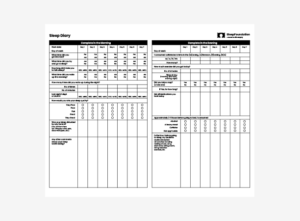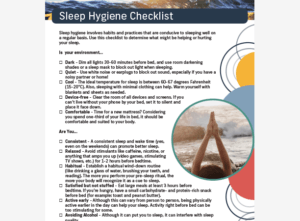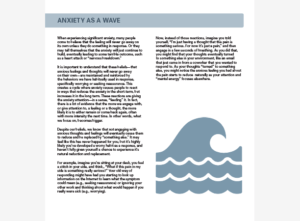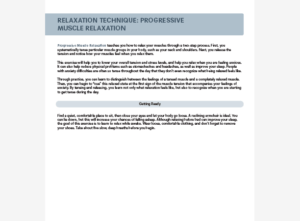
Sleep
Getting quality sleep is one of the most important contributors to your overall physical and mental health. Unfortunately, problems related to sleep are common and have wide-ranging negative impacts on our health, daily functioning, and relationships. To improve your sleep health, our care team has put together this self-care package in hopes that you’ll catch more peaceful zzzz’s.

What You’ll Learn About Sleep Health
- The basics of sleep, it's affect on our health, and self-assessment
- Regular practice of sleep behaviors to get a good night's rest
- How lifestyle choices translate to better sleep (plus pregnancy tips)
- Chronic sleep difficulties resulting from underlying medical conditions
- Relaxation exercises
- How your Crossover care team can help
Expert Guidance Along the Way
-
James Marinchak, PsyDClinical PsychologistJames is a Clinical Psychologist with degrees from the University of Maryland and Rutgers University. He loves being asked by our members to join with them in the process of healing and change and to work collaboratively on something important in their life. He is specialized in adult and adolescent anxiety, OCD, and trauma.
If you’ve ever experienced trouble falling asleep or had a sleepless night, you’re not alone. On any given night, about 35% of the population is having difficulty sleeping. Sleep is essential for your physical and mental health, as well as for your social well-being. Knowing how to optimize your sleep can lead to greater productivity, an optimistic outlook, and a longer, happier, and healthier life.
Chronic sleep issues or sleeping less than 7 to 9 hours each night for an extended period of time can leave you vulnerable to disease or other medical issues and may set you up for emotional and cognitive issues, including increasing feelings of depression and anxiety.
Think about how you feel after just one night of poor sleep—you can be fatigued, have judgment errors, and your appearance can even change (hello, dark circles and droopy eyes!).
The good news is that knowing how to get good quality sleep can lead to greater productivity, an optimistic outlook, and a longer, happier, and healthier life.
Why is Sleep Important?
Did you know that all animals and many plants sleep? While how sleep evolved (and why) is not fully understood, scientists have learned that as life evolved, circadian clocks, found in the cells of all organisms, gradually developed. These internal clocks regulate body systems and are highly attuned to variations in light. Sleep seems to offer a time to reset these clocks, enabling you to function at your best.
Sleep is as essential for your survival as food and water. It’s so important to how you operate that humans spend one-third of their lives engaged in sleep. The quality of your sleep has a major impact on how well you manage the other two-thirds of your life—it can even affect how long you live.
Benefits of Sleep
- Helps you reset your body’s internal clock
- Improves longevity
- Improves your ability to think and to problem solve
- Allows new learning to take hold and memories to be processed and consolidated
- Promotes body tissue repair, energy restoration, and cleanses the brain of toxins
- Protects skin from the negative effects of sun exposure
- Fights off disease, increases stamina, and slows down aging
- Helps regulate metabolism
- Decreases sugar cravings
How Sleep Works
You may think of sleeping as shutting down and resting. While it is definitely restorative, there’s a lot going on in your body while you slumber. Sleep is a well-orchestrated effort that requires many parts of your brain to work together. Understanding how your brain manages sleep can give you a new appreciation for just how amazing your body really is, and help you become more mindful of the impact your lifestyle choices can have on your health. Although how sleep actually works is not fully understood, here is a brief explanation of the major contributors.
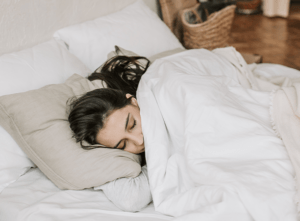 Sunlight plays the lead role in initiating the sleep-wake cycle. It might come as a surprise to learn that a great night of sleep actually begins in the morning. There is a gland in your body that produces melatonin, which is the hormone that is in charge of your sleep-wake cycle. That gland responds to light, so in the morning, the gland starts to decrease the melatonin in your body, prompting you to wake up. Morning sunlight also cues the hypothalamus, known as the “control center of your circadian clock,” to increase levels of arousal and alertness.
Sunlight plays the lead role in initiating the sleep-wake cycle. It might come as a surprise to learn that a great night of sleep actually begins in the morning. There is a gland in your body that produces melatonin, which is the hormone that is in charge of your sleep-wake cycle. That gland responds to light, so in the morning, the gland starts to decrease the melatonin in your body, prompting you to wake up. Morning sunlight also cues the hypothalamus, known as the “control center of your circadian clock,” to increase levels of arousal and alertness.
Throughout the day, your hypothalamus helps you build “sleep pressure,” i.e., the feeling of being tired or sleepy at night. As you get into the evening hours, the pineal gland senses decreased light and your melatonin production increases. Your circulatory system then transports that melatonin throughout your body which increases the feeling of being sleepy and “ready for bed.”
The Sleep Cycle: Five Stages of Sleep
Your body generally goes through five stages of sleep each night. Though all stages serve a function, deep sleep (stages 3 and 4) and REM are vital to feeling rested and restored when you wake up. Stages 1-4 occupy the first half of the sleep cycle, with REM by itself taking up the entire second half. . Let’s explore how the five stages work together to produce some high quality zzzs.
- STAGE 1:
- Light sleep during which you are easily awakened
- Lasts only 1-5 minutes
- Neither restorative or refreshing
- STAGE 2:
- Longest stage of sleep
- Heart rate and body temperature drop
- Deeper than Stage 1 but not restorative
- STAGE 3:
- The beginning of deep sleep
- Muscles relax and breathing slows
- Hard to awaken from Stage 3 sleep
- Feelings of disorientation and grogginess when awoken
- The beginning of deep sleep
- STAGE 4;
- Known as “priority sleep,” this is when the body repairs itself by creating:
- Hormones essential for healthy digestion and repair of tissues, bone, and muscle
- Neurotransmitters essential for focus, learning, and mood
- Specific cells that strengthen the immune system
- Growth hormone necessary for strength, endurance, and stamina
- Deepest sleep and the hardest stage from which to wake
- Avoid driving or making important decisions if you are coming out of Stage 4 sleep
- Known as “priority sleep,” this is when the body repairs itself by creating:
- Stage 5: REM Sleep
- REM accounts for about 20 to 25% of our sleep
- You have your most vivid dreams in this stage and your eyes move back and forth
- You may awaken from a dream state since REM occurs closer to morning
- Memories are consolidated and emotional material is processed
- Increases creativity and daytime efficiency
- Your arms and legs exhibit muscular paralysis so that you don’t act physically in response to your dreams
- In rare instances, individuals experience the opposite, known as REM Sleep Behavior Disorder, where they act physically, such as punching or kicking, while asleep
Consequences of Poor Sleep
Sleep deprivation, also known as sleeplessness or sleep insufficiency, is a condition where one does not have enough high quality sleep to support alertness, performance, and good health. Prolonged sleep deprivation (less than seven hours of sleep most nights over a period of several weeks) disrupts your brain and your body’s normal functions. This can lead to multiple negative health consequences, including:
- Excessive daytime sleepiness and fatigue
- Frequent yawning
- Irritability
- Depression and anxiety
- Chronic pain
- Memory impairment and forgetfulness
- Poor concentration
- Weight gain
- Low libido
- Increased risk of early death due to:
- Cardiovascular disease
- Type 2 diabetes
- High blood pressure
- Weakened immune system
- Higher risk of accidents or falls
The best way to prevent the consequences of sleep deprivation is to practice good sleep hygiene (which we explain in the following pages) and ensure that you get adequate sleep. Recommended guidelines for adults is an average of 7–9 hours of good rest per night, though the exact number of needed sleep hours varies from person to person.
Tracking Your Sleep
Tracking your sleep can be a very useful exercise when trying to learn more about your sleep habits. You may discover how many total hours you sleep each night and how many times you wake up, and then be able to relate it to how much energy you have the next morning, and the impact other lifestyle factors such as exercise, diet, stress, and your environment, have on your sleep.
Sleep Tracking Apps
 Sleep apps can track your sleep and when you wake up, you can see your own hypnogram. A hypnogram shows you visually how much time you spent in each stage of sleep during the night. You’ll be able to see how long you slept, how many times you woke up, and how much REM and deep sleep you had. Some apps show you other things that also affect sleep (and overall wellness) like body temperature, heart rate, and how restless you were while sleeping.
Sleep apps can track your sleep and when you wake up, you can see your own hypnogram. A hypnogram shows you visually how much time you spent in each stage of sleep during the night. You’ll be able to see how long you slept, how many times you woke up, and how much REM and deep sleep you had. Some apps show you other things that also affect sleep (and overall wellness) like body temperature, heart rate, and how restless you were while sleeping.
Wearables
You may already have access to a sleep tracking app if you own a Fitbit or an Apple Watch. Newer devices that you wear (also known as “wearables”) can be expensive, but may give you new ways to discover the secrets of your sleep. Sleep tracking wearables are helpful, but they are not meant to take the place of sleep studies or evaluation and treatment of possible sleep disorders.
However, if you are having sleep issues and are tracking your sleep with an app but aren’t sure how to read it or what to do about what you see, talk to your Crossover provider. Your data might be useful in learning more about your sleep and how to improve it.
Sleep Journal
Keeping a sleep journal is not only free, it can be a very valuable tool. Writing activities and results down for a few weeks can show you what might be interfering with getting a good night’s rest. For example, you may learn that drinking caffeine in the afternoon makes it harder to fall asleep that night. If that is the case, you may want to set a cut off time for caffeine and then reassess your sleep pattern from there.
In your sleep journal, consider tracking the following throughout each day leading up to sleep:
- Any naps during the day
- Intake of caffeine, alcohol, and tobacco
- Amount of exercise
- Level of stress
- Time you go to bed
- How long you notice you’re awake before falling asleep
- Total hours of sleep
- Wake-up time
- Interruptions that occurred
- How you feel in the morning
- Additional information you feel is related to your sleep
Tips for Getting Better Sleep
In the first section, we went over how important a good night of sleep is for your overall health and wellness. We also went over the stages of sleep, what can affect your sleep quality, and how to track your sleep in an effort to identify ways to sleep more soundly.
You may want to consider downloading the worksheets below, which were created to help you figure out what areas of your life might be affecting your sleep. Then, keep reading for more information on what can affect your sleep, tips about how to create a consistent sleep schedule, how to cope when others affect your sleep, and ways you can adjust your bedroom environment to improve your sleep quality and quantity.
Coping with Challenges-Getting Enough Sleep
Sleep Schedule
When you aren’t getting good sleep, or enough of it, it’s often because the natural rhythms of your body are fighting with signals from your brain. These brain signals—called zeitgeber or “time-giver” in German—are used to reset your body’s internal clock. But when zeitgebers from your brain are in conflict with your body’s natural rhythms, it can help to use an external signal to give your body a sense of when it’s time to sleep and when it’s time to wake up. Thankfully, there are lots of other signals your body will respond to. Below are some examples.
- Light (natural or artificial)
- External temperature
- Core body temperature
- Social interaction
- Eating
- Drinking
- Posture
- Exercise
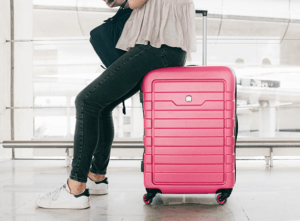 If you’ve ever had jet lag, you know how it feels when your body and your brain are trying to do two different things. For example, if you take a flight and land in a new place in what would be the middle of the night at home, your body might be ready for sleep. But if it’s noon wherever you are, your environment is telling you to stay up and go eat lunch. You’re tired, but wired. Using an external signal, like getting sunlight exposure at this time—despite your body’s drive to sleep in a dark room—can help shift your body’s internal clock closer to the timing of the environment. This will help you sleep better that night and be more awake the next day.
If you’ve ever had jet lag, you know how it feels when your body and your brain are trying to do two different things. For example, if you take a flight and land in a new place in what would be the middle of the night at home, your body might be ready for sleep. But if it’s noon wherever you are, your environment is telling you to stay up and go eat lunch. You’re tired, but wired. Using an external signal, like getting sunlight exposure at this time—despite your body’s drive to sleep in a dark room—can help shift your body’s internal clock closer to the timing of the environment. This will help you sleep better that night and be more awake the next day.
The Importance of Routine
In “Basics of Sleep Explained” (the first section), you learned that a circadian rhythm is an internal clock that regulates your body systems, and that it is very responsive to variations in light. Your body is at its healthiest when your behaviors are in sync with a strong circadian rhythm. One way to ensure a strong circadian rhythm is by performing the same activities each day at the same time. Doing this will give your body a more accurate sense of time—you will be more alert during the day and sleep better at night.
Below are some examples of how you can use the above zeitgebers to help create a strong circadian rhythm:
-
- Wake up at the same time every morning regardless of how long you slept.
- Go outside for 10-30 minutes immediately after waking up.
- Exercise in the morning.
- Eat breakfast at the same time every day.
- Be upright during the day and lay down at night.
- Give your body time to digest by eating dinner 2-3 hours before bed.
- Get routine sun exposure near the time of sunset.
- Ideally, you should avoid screens 2-3 hours before bed. Adapt this based on your goals and what is realistic for you.
- Wear blue blocking glasses indoors past dark (you can find them from most eye doctors or online).
- Create a calm, peaceful bedtime routine you can follow every night—for example, you could wash your face, read for 20 minutes, and do a short, guided meditation after turning the lights out.
- Go to bed within the same 30 minute time window each night.
- For the most consistent, successful results, try to keep these routines in place seven days a week (going off track on the weekend means starting over every Monday).
Naps and Sleep Difficulties
At a young age, you probably learned that naps are a helpful way of resting and “recharging your batteries.” Some cultures value naps so greatly, they are incorporated into everyone’s daily lives—even in the workplace! However, while many experience napping as a helpful practice, for those with nighttime sleep difficulties, naps may have the opposite effect.
If you are sleep deprived, naps offer the short-term benefit of feeling more rested, but can also cause long-term consequences by making you less tired than you need to be at night when you’re actually trying to fall and stay asleep.
Nap Education: Our Sleep and Awake Energy Reserves
To understand why naps can actually have a negative effect at times, it is helpful to think of your brain as containing two separate energy reserves. Picture two tanks—one contains your “sleep” or tired feeling, and the other contains your “energy” or your awake feeling. Throughout the day and into the night, these two tanks fill and drain in opposition to one another.
Ideally, after a full night’s rest, you wake up with an empty “sleep” tank (because you used up all that sleep during the night). Your “awake” tank on the other hand, should be filled up and ready to go, thanks to all that rest.
 As you go about your day, your awake tank slowly empties as you use energy to get through your activities, and at the same time, your sleep tank slowly fills back up to get ready for bedtime. By then, your sleep tank should be full and ready for you to dive in, and your awake tank should be empty and ready to refill itself while you rest.
As you go about your day, your awake tank slowly empties as you use energy to get through your activities, and at the same time, your sleep tank slowly fills back up to get ready for bedtime. By then, your sleep tank should be full and ready for you to dive in, and your awake tank should be empty and ready to refill itself while you rest.
So, when we nap during the day, we’re emptying a bit of our sleep tank instead of just using our awake reserves. While napping adds more short-term awake energy, it gets us into long-term trouble in two ways:
- It uses sleep energy that was building during the day, meaning that when we try to fall asleep at night, we’re not at full capacity. Because your brain doesn’t get that “full sleep tank” signal that tells you you’re ready for bed, it has a harder time knowing it’s time to sleep, resulting in being “too awake” at bedtime.
- You may also have trouble staying asleep for the duration of the night due to the tank “getting too low” in the middle of night, essentially tricking your brain into thinking your sleep tank is just about empty and it’s time to wake up.
Cutting Out Naps: Tips and Strategies
If you tend to nap regularly at around the same time and place, your brain comes to “expect” the nap by making you feel especially sleepy/drowsy around that time. Therefore, you may find it easier to just keep going with the daytime napping habit, even if it means keeping you trapped in a poor sleep cycle at night. The good news is that while breaking napping habits can involve some short-term adjustments, the benefits of a more regular sleep/wake cycle often don’t take long to kick in, and they tend to last!
Tips to quit napping
- Plan your “Nap Quit” date in advance.
- When making any kind of behavior change, selecting a start date ahead of time increases a sense of commitment and personal control
-
- Because you’re likely to feel more tired and irritable on your “Nap Quit” day, plan for a day where you don’t have a lot of commitments or responsibilities, such as a day off.
- Try to plan a day where you can step away from places you usually nap, to minimize the urge to lay down and rest.
- Adjust the way you think about napping.
- If you think about your naps as necessary and helpful, remind yourself how unhelpful they’ve actually been. Ask yourself some key questions:
- Has napping made it easier for me to fall asleep or stay asleep at night?
- Do I feel like I’ve become more dependent on napping?
- What do I potentially stand to gain from eliminating naps from my daily life?
- If you want to stop napping but think you’ll be too tired to function, consider alternative possibilities and trying to adjust your mindset. For example:
- “If I skip my nap, I won’t be able to function.” → “I’ll definitely be more tired for the rest of the day, but I’ve been able to get through days in the past even when I was up really late the night before.”
- “I’m going to be so irritable the rest of the day. No one will want to be around me.” → “I’ll probably feel tired and cranky, but I can just tell people I’m trying to improve my sleep quality. I think they’ll be supportive and hopefully they’ll give me some space until my sleep gets better at night.”
- “I need my nap to catch up on sleep I didn’t get from the night before.” → “My nap is actually preventing me from catching up on my sleep by making it harder for me to fall/stay asleep at night. Not napping will actually help get me to where I want to be.”
- If you think about your naps as necessary and helpful, remind yourself how unhelpful they’ve actually been. Ask yourself some key questions:
- Plan activities away from nap areas.
- Here are a few suggestions to help you get through your normal nap time:
- Go for a walk or bike ride
- Listen to upbeat, energetic music
- If it’s sunny outside, try to either be outside or have blinds/curtains open to let in sunlight
- Exercise
- Plan a conversation with a friend
- Do a mental activity such as a puzzle or game, but don’t worry about the outcome—just keep your brain occupied
- Here are some behaviors to avoid when cutting out naps:
- Drinking coffee or other caffeinated beverages to stay awake.
- Sitting or relaxing in areas where you normally nap
- Eating a big meal either before or during the time you normally nap
- Wearing pajamas or other clothing you like to sleep in
- Sitting in low or dim lighting
- Reading in a comfortable chair or listening to soft, slow music
- Here are a few suggestions to help you get through your normal nap time:
- Talk with others and ask for support.
- Cutting out naps isn’t easy and goes better when you have support from others. Here are some examples of ways friends and family can help you break the napping habit:
- Planning activities with you during the time of day when you normally nap
- Giving you judgment-free space if you ask for it because you’re feeling irritable
- Avoiding offering you caffeinated beverages (or consuming them when they’re around you)
- Providing words of encouragement and support
- Cutting out naps isn’t easy and goes better when you have support from others. Here are some examples of ways friends and family can help you break the napping habit:
Wind-Down Routine
Chances are you or someone you know has a particular process for getting an active baby or child in their life ready for sleep. It could be any combination of a warm bath, light snack, back rub, quiet reading, dim lights, or soft music/lullabies that help the little one relax their busy body and prepare for rest. Adults benefit from the same kind of routine!
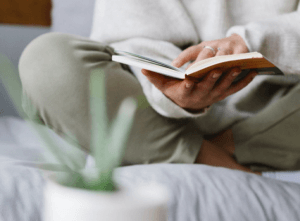 Your personal wind down routine should be something calming that you do each evening for about 30-60 minutes before going to bed. The routine can include activities that help quiet your mind and body, and when done consistently, can become an important (and enjoyable!) part of maintaining consistency with your sleep habits.
Your personal wind down routine should be something calming that you do each evening for about 30-60 minutes before going to bed. The routine can include activities that help quiet your mind and body, and when done consistently, can become an important (and enjoyable!) part of maintaining consistency with your sleep habits.
There are many benefits to having a wind down routine. They help your brain move away from focusing on the stressors of the day and towards relaxing yourself instead. They also help you start to transition into feeling more sleepy, cueing your brain to recognize that it’s time to settle down and get ready for sleep. Best of all, wind down routines give you time to engage in quiet activities that you enjoy and that help you practice being present in the moment.
To create a wind-down routine
- How much time do you need to wrap up your day and get ready for bed? We recommend a wind-down routine that is between 30 minutes and 2 hours long.
- What types of activities help you relax? Examples include taking a warm bath or shower, reading a book (ideally not on a device and nothing too stimulating), knitting, working on a puzzle, drawing, listening to music, meditating, stretching, journaling, talking to your friends or family, and completing your evening hygiene needs, such as brushing your teeth and washing your hands and face.
- Does your current routine involve a device or electronic? You may want to reconsider including this activity as devices are known to stimulate the brain and may interfere with your sleep.
- What can support you in following your wind down routine? Maybe setting a reminder each night will help you start your routine at the right time. You could also make a short list of wind down activities to follow until it becomes a habit. Think about what will relax you and how long you need for each activity, and create a reminder from there.
Bedroom and Bed Use
If someone were to ask you to think of all the things you do in your bed besides sleep, you might picture yourself lying in bed reading something interesting, watching a movie or TV show with a bag of popcorn by your side, or scrolling social media on your phone. While there are many different things we do in bed, when we’re having difficulty sleeping, these non-sleep behaviors can actually make the problem worse.
The Power of Associations
For many of us, doing “awake” behaviors such as reading or watching television in bed doesn’t create a problem. However, if you’re having a hard time falling asleep and you combine that with non-sleep/non-sex-related activities in the bedroom, when you do engage in a sleep activity—like just lying in the dark—it can still be hard to fall asleep. The reason for this is because your brain has the ability to make associations with your environment. If you’re active in your bedroom and doing things other than sleeping or having sex, your brain associates that space with being awake, rather than with sleeping. That association affects how you feel in the bedroom and in bed, too (again, awake instead of sleepy).
When you’re sleeping well and your sleep schedule is normal and well-regulated, your brain associates your bed, bedroom, and nighttime with either sleeping or feeling ready to sleep. Even before your head hits the pillow, your brain has begun “powering you down” (i.e., making you feel drowsy) by responding to associations with your bedtime routines like putting on pajamas and brushing your teeth.
However, when you’re not sleeping well—meaning you are spending a lot of time in your bedroom being awake—the opposite tends to happen. Your brain can begin to create nighttime associations with being awake and alert, instead of asleep. If this is the case for you, then any behaviors you do in your bed that don’t involve sleep, will reinforce that association between being in bed and being awake—no matter what time of the day (or night) it is.
Tips for Bedroom Use
- Use your bed for sleep or sex only
- Only get into bed at night after your wind down routine when you are already feeling tired/drowsy
- Stay in other rooms of your home at night until you feel ready for sleep, even if it takes longer than anticipated
- If you finish your wind down routine, go to bed, and are still unable to fall asleep within 30 minutes, leave the bedroom and go into another area of the home until you feel tired enough to go to sleep.
Remember, the goal is to have your brain begin to “re-associate” your bedroom, bed, and pillow with feeling “ready for sleep.”
Recommended Bedroom Uses to Avoid/Discontinue
If you’re experiencing sleep difficulties, try to avoid the following behaviors in your bed or bedroom at any time throughout the day, but especially in the evening and at nighttime.
- Being on your phone or a tablet—avoid scrolling, social media, email, games, etc. (see Electronics and Devices later in this section)
- Watching TV/movies
- Eating/drinking
- Reading or games such as crossword puzzles
- Strenuous, prolonged exercise right before bed
- Performing job or work-related duties, even sitting at a desk in the bedroom
When Others Affect Your Sleep
Over 60% of Americans regularly share their bed with another person—and children and pets often make their way under the covers as well. And even if you do have your bed to yourself, you might have noisy (snoring) roommates. But you don’t have to live alone to get good quality sleep. Below are some general tips for improving sleep, even if you share your bed or home.
Sharing your bed with a partner
Sharing a bed with a partner can have some sleep benefits (like increased REM sleep), but it can also lead to common problems. Here are a few ideas that might help:
- Try to align your sleep schedules A study published in Sleep Health noted that couples who went to bed within 30 minutes of each other had the least disruptions. If you and your partner don’t usually go to bed around the same time, talk about it. Things that are important to discuss are when will you go to sleep and wake up, what kinds of alarm sounds work for both of you, and the ever-present question—to hit snooze or not (and how many times)? Once you’ve agreed on a few solutions, try them out for a week or two. You may both be pleasantly surprised at the results.
- Create guidelines that work for both of you Sometimes it’s the simple things that can improve your sleep quality. Maybe you prefer a warmer blanket, or they like waking up to sunlight streaming in through the window. Find some compromises and places where each of you can make sacrifices for the other. Perhaps you can wear warmer pajamas or grab an extra blanket so your partner can stay cool. Sleeping with a sleep mask on might help you avoid the sunrise so you can catch a few extra minutes of sleep in the morning. Just communicate with one another and be creative to find the solution that works for you both.
- Separate rooms Sometimes people (or schedules) are just not compatible for sleeping.That’s okay! If you have access to a guest room, couch, or separate room to sleep in that may be a possible solution. This does not have to be a permanent change—use it as needed. For example, if one of you has to catch an early flight, or has an early meeting or workout planned, sleeping (and waking) separately helps both of you reach your goals. This is not a sign that your relationship is failing or in trouble. It just means you value your sleep and respect their late night or early morning routine.
- Adjust sleep arrangements for movement disruptions People move in their sleep. Sometimes it is due to conditions like restless leg syndrome, sometimes it is a reaction to dreams, or some people are just restless sleepers. Either way, the movement can wake a partner. Some tips for this could be using two twin beds pushed together (this is common in some European countries), sleeping separately, or helping a sleep partner seek treatment for a possible underlying medical condition.
- Sharing a room with a partner who snores or has sleep apnea More than half of men snore. Women aren’t far behind—around 40% saw logs nightly. If you sleep with a noisy partner, try earplugs, headphones, or asking them to sleep with their head elevated, which can reduce snoring.
Sharing your bed with a pet
Animals provide a great deal of comfort, support, and are a part of the family. As adorable as your pets are, if they wake you up at 4am, whine at night, or scratch to be let up (or out), it’s not good for you and your sleep quality.
Sometimes extra training can be helpful if your dog’s behavior is affecting your sleep. They can be trained not to jump on the bed, to wait to go outside until morning, or to go to their bed on command. You can also crate train them, and place the crate outside of your bedroom if you don’t want them sleeping in there with you. It’s not a punishment for them—most dogs are the happiest when they know they are pleasing their person!
Living with roommates or in a noisy situation
Sometimes those who affect our sleep are not sharing a bed with us. They can be noisy roommates or neighbors, too. What can we do then?
- Have a conversation Communicate with your roommate. They may not know their schedule or lifestyle is affecting your sleep. Ask if they can be more quiet when they arrive home, or if they can avoid turning on extra lights or music if they know you’re asleep.
- Be creative If you have noisy neighbors, try wearing earplugs, earphones, or using a noise machine to help create a quiet, restful environment. If neighbors get up early on Friday, or the gardener starts mowing the lawn before you need to get up on Wednesday, think about going to bed earlier on those nights so you can still get the sleep you need.
Sleep Environment
Even while you sleep, your five senses are still working and responding to what’s going on around you. Making changes or adjustments to your sleep environment—even ones that are subtle—can have powerful effects on your sleep quality. Keep reading further to learn ways you can create a sleep environment full of sensory cues that promote sleep and rest.
Light
Sunlight directly affects sleep because it plays a key role in dramatically regulating your circadian rhythms through the production of two hormones in your body: cortisol, which helps you stay alert, and melatonin, the hormone that helps you sleep.
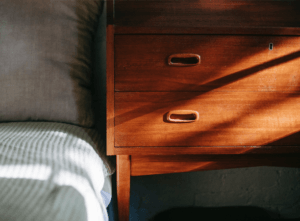 There are a few ways natural light helps us sleep. Early morning sun exposure triggers an ideal spike in cortisol levels. That cortisol sets an internal timer inside your body, telling it to release melatonin 12-14 hours after the spike. This natural increase in melatonin in the evening causes a cascade of internal events (body temperature lowers, feelings of fatigue set in, etc.) that prepare the body for sleep.
There are a few ways natural light helps us sleep. Early morning sun exposure triggers an ideal spike in cortisol levels. That cortisol sets an internal timer inside your body, telling it to release melatonin 12-14 hours after the spike. This natural increase in melatonin in the evening causes a cascade of internal events (body temperature lowers, feelings of fatigue set in, etc.) that prepare the body for sleep.
When you are indoors, sunlight is 100x less bright than it is when you are getting sun exposure outdoors. So just getting sunlight through a window or your windshield is 50x less effective at setting your internal melatonin clock.
So, it’s important to try to spend a bit of time outdoors to gain the benefit of sunlight on your sleep/wake cycle:
- When possible, get outdoors each morning for 10-30 minutes (ideally when the sun is just rising and is low in the sky: before 8:30am).
- Then, before the sun goes down, spend a bit of time outside again. Not only will it help you catch some zzzs later, you just might enjoy some beautiful sunsets along the way!
Artificial Light
Along with sunlight, artificial light (lamps, indoor lighting, electronics, etc.) has a big influence on our circadian rhythms. Too much artificial light in the evening can cause us to stay up later than we prefer and negatively impact our overall sleep.
To reduce any negative effects artificial light might have on your sleep, try:
- If you wear glasses, consider talking to your optometrist about blue blocking lenses to soften the impact of light from digital screens on your eyes
- Using warm, dim lights in your home in the evening
- If some lights at home are adjustable, consider placing lower-adjusted ones close to where you sit in the evening
- Reducing your use of all electronics and devices in the evenings
- Keeping your bedroom as dark as possible
- Considering installing blinds or black out curtains
- Using an eye mask
- Using a basic alarm clock in place of an alarm app on a device
Electronics and Devices
 Using electronics and devices (phones, tablets, TVs, computers, e-readers, smartwatches, etc.) close to bedtime can stimulate your mind and brain making it even harder to fall asleep. Indoor lighting and electronics both produce “blue light” which can delay when and how you fall asleep. If you get caught up in what you’re reading, or if it makes you feel anxious for some reason, it can increase dopamine in your brain. Dopamine is a hormone that makes you feel good—but it also slows the production and release of melatonin.
Using electronics and devices (phones, tablets, TVs, computers, e-readers, smartwatches, etc.) close to bedtime can stimulate your mind and brain making it even harder to fall asleep. Indoor lighting and electronics both produce “blue light” which can delay when and how you fall asleep. If you get caught up in what you’re reading, or if it makes you feel anxious for some reason, it can increase dopamine in your brain. Dopamine is a hormone that makes you feel good—but it also slows the production and release of melatonin.
Tips for use of electronics and devices
- Try to limit the use of screens within 2-3 hours of your bedtime.
- Use night mode, which reduces blue light coming from your devices (you can also download and install blue-blocking software onto your electronic devices).
- Try making your bedroom a device-free zone.
- Avoid looking at your devices if you wake up during the night
Noise
A quiet room is essential for great sleep. According to the World Health Organization, “noise pollution” can wake you up at night and make you tired, grumpy, and depressed during the day. Your body interprets nighttime noises as stress, and responds by releasing stress hormones, especially cortisol. High cortisol levels at night take a toll on our overall health, leading to cardiovascular disease, obesity, hypertension, and diabetes.
Tips for creating a quiet sleep environment
- Minimize noise levels as best as you can; consider using ear plugs if you can’t control the noise around you.
- Ask those you live with to respect your need for a quiet space in which to sleep.
- Keep your phone on silent or in Do Not Disturb mode.
- Use a white noise machine
- Keep volume at a comfortable decibel level to help block out unwanted noises so you can fall asleep faster.
- While white noise can help you fall asleep, it can also wake you up during the night and affect how long you are in deep sleep stages. Set a timer so your white noise turns off a short time after you fall asleep.
- If you do not have a white noise machine, try using a fan.
- Try listening to music while you’re falling asleep
- Music can help reduce cortisol, pain perception, and negative thoughts.
- Listening to soothing music as you settle in for sleep can increase oxytocin (a feel-good hormone)
- Music that feels soothing to you can lower stress hormones, helping your body relax. This helps you experience more deep sleep.
Temperature and Pajamas
One of the most important steps you can take to enjoy great sleep is to try to regulate your temperature. As bedtime approaches, your circadian clock activates a thermostat, slightly lowering your body temperature. This decrease in body temperature signals to your body that it’s time to release melatonin.
Once you enter the REM stage of sleep, your ability to regulate body temperature is somewhat decreased, so the temperature that felt right when you were falling asleep might also disrupt your sleep during REM. Older adults are especially dependent on being able to control bedroom temperatures at night.
Tips for regulating both body and room temperature:
- Keep your room temperature between 60-68* F. Ideal is 65* F.
- Have a variety of blankets near your bed, so if you get too cold or too hot, you can adjust layers.
- If your room is hot or humid, consider using air conditioning or a fan for the first few hours of the evening to help cool the room before bedtime.
- If your partner or pet tends to warm up the bed, consider using twin-sized or individual blankets to avoid trapping heat between partners.
- Choose breathable fabrics, such as cotton and bamboo, and pajamas that are comfortable and allow you to move freely.
- Wear lightweight socks if your feet tend to get cold.
- If you experience night sweats, even after adjusting other factors affecting temperature, check with your primary care provider for further evaluation.
Air Quality
Poor air quality and ventilation increases carbon dioxide (CO2) levels, which results in poor sleep quality, daytime fatigue, and stale air.
Poor air quality can be caused by a number of factors, such as:
- Old ventilation systems and HVAC filters
- Drier air when the heat is on
- Seasonal allergens
- Living in high-pollution areas
Whatever the cause, poor air quality makes it harder to breathe before and during sleep, which in turn makes it harder to fall asleep and receive the restorative benefits of deep sleep.
Tips to improve air quality for better sleep
- Open a window: Even getting just a little natural, fresh air into your sleep environment helps. If you have more than one window you can open, that can allow for cross ventilation and for dust particles to exit.
- Use an electronic air filter/purifier: These have become increasingly popular as a way to clean up the air you breathe, creating a fresher room and better breathability. Filters trap pollutants, bacteria, and allergens in the air, and purifiers use a special light to “zap” them out of the environment.
- Change HVAC filters regularly: The change frequency recommendation for single-family homes is every 90 days, but this increases to every 60 days if you own pets.
- Regularly clean and dust your sleep environment (and home)
- Wash/change sheets weekly: This can reduce dust and other allergens from building up.
- Use dust mite pillow covers: These hypoallergenic covers are less likely to cause or contribute to allergic reactions, and they prevent dust mites from attaching to your pillows and bedding.
- Create bedroom boundaries with pets: Shedding, dander, and uncomfortable sleep positions often create a need to set some limits. If keeping them out of the bedroom feels like too much, consider a pet bed.
- Add snake plants to your sleep environment: Snake plants (Sansevieria) filter out CO2 and other toxins at night, and release air-purifying O2 while you sleep.
Nutrition
 How, when, and what you eat can affect your sleep, and this can vary from person to person. Certain foods and substances worsen your sleep quality, making it hard to fall asleep and causing you to wake up more often overnight. Eating a well balanced diet and a variety of foods can help promote better sleep.
How, when, and what you eat can affect your sleep, and this can vary from person to person. Certain foods and substances worsen your sleep quality, making it hard to fall asleep and causing you to wake up more often overnight. Eating a well balanced diet and a variety of foods can help promote better sleep.
Things that Lead to Poor Sleep
- Caffeine–If you’re having trouble falling asleep, consider creating a cut-off time for caffeine during the day. The FDA recommends limiting total caffeine intake to less than 400mg per day. For reference, one 8 ounce cup of black coffee has about 95mg of caffeine, and an 8 ounce cup of black tea has about 47mg of caffeine.
- Alcohol–While alcohol may help you fall asleep, it also causes more frequent overnight waking and less restful sleep overall. For some people, alcohol may also worsen snoring and symptoms of sleep disorders. Limit alcohol consumption close to bedtime, ideally stopping at least two hours before you plan to sleep. The U.S. Dietary Guidelines recommend limiting alcohol to one drink per day for women and two drinks per day for men. One drink is 12 ounces of beer, 5 ounces of wine, or 1.5 ounces of hard liquor.
- Saturated fats–Foods high in saturated fats lower your levels of serotonin, which can lead to insomnia. Sources of saturated fats include fried foods, fatty cuts of meats, lard, cream, and pastries.
- Large meals–Having a large meal close to bedtime can worsen acid reflux and cause bloating, making it difficult to fall asleep. Try to avoid large meals and foods that trigger your symptoms, especially in the evening. Consider eating smaller, more frequent meals throughout the day instead.
- High amounts of simple carbohydrates–A diet high in simple carbohydrates, such as refined grains, sweetened beverages, and added sugars, reduces REM sleep and increases overnight waking.
Things that Help Improve Your Sleep
- Consistent, balanced meals and snacks–Eating protein, healthy fats, and fiber help regulate hunger and blood sugar levels.
- A diet full of fruits and vegetables–Eating fruits and vegetables daily ensures you’re getting a variety of vitamins and minerals. Try to fill about half of your plate with fresh fruit and vegetables at most meals.
- Healthy fats–Foods like fatty fish, avocados, olive oil, walnuts, almonds, chia seeds, flaxseeds, and hemp hearts improve your serotonin levels.
- Water–Even slight dehydration can make you feel more tired and less energetic. It can also lead to headaches and muscle cramps, making it harder to sleep. The best way to tell if you’re hydrated is to make sure your urine is pale to light yellow in color. If it is darker, you likely need more water.
- Magnesium–Magnesium promotes feeling calm and relaxed, and helps regulate melatonin, the hormone associated with your sleep-wake cycles. Good sources of magnesium are leafy greens, nuts, seeds, whole grains, and legumes.
- Zinc–Zinc helps you fall asleep and feel more rested overall. Good sources of zinc are chicken, eggs, oysters, seafood, meats, beans, lentils, nuts, seeds, and soy.
Movement
Regular physical activity and movement is not just good for your general health, it can also help improve your ability to fall asleep as well as your overall sleep quality. Exercise can help support sleep by:
- Increasing feelings of relaxation
- Helping to manage stress and improve mood
- Reducing anxiety that can disrupt sleep
- Increasing the amount of deep sleep, leaving you more rested and energized the following day
Research shows you get the most sleep benefit when you exercise for one hour about four to eight hours before your bedtime. There’s no one way to do it—the best type of exercise to do is the one you enjoy the most.
For some people, exercising within four hours of going to bed can interfere with your sleep. If you notice that you are struggling to fall asleep or having poor sleep after exercising close to bedtime, you may want to exercise earlier in the day. Keeping a sleep and exercise journal can help you identify any patterns.
Stress
Worrying about things like work, family, health, and finances add to your emotional load and often impact sleep. And researchers agree that the quality of your sleep is directly related to how stressed you feel. So lowering your stress levels can not only improve sleep, but reduce your risk of illness, and increase your enjoyment of life. Developing healthy and effective coping mechanisms can change how you manage stress and how you sleep. If you feel your stress level is affecting the quality of your sleep and you need help managing it, please reach out to your Crossover provider—that’s what we are here for.
 Work stress can be particularly hard on your health. One third of the workforce has high blood pressure. Workers who have chronic stress, poor sleep patterns, and hypertension have a three-times higher risk of having a heart attack than those who do not have this deadly combination. Jobs that place high demands on their workers but offer little control over decision-making can also have a negative impact on sleep.
Work stress can be particularly hard on your health. One third of the workforce has high blood pressure. Workers who have chronic stress, poor sleep patterns, and hypertension have a three-times higher risk of having a heart attack than those who do not have this deadly combination. Jobs that place high demands on their workers but offer little control over decision-making can also have a negative impact on sleep.
Tips to manage stress for better sleep:
- Create “me time” during the day—use pockets of free time to do things that make you feel relaxed and calm like meditation, stretching, a short walk, or a 10-minute exercise session.
- Spend a bit of time outside each day. Spending just 30 minutes a week in nature has been found to lower depression and blood pressure. Make time to rejuvenate!
- Get movement daily (see Movement section)
- Eat nourishing foods and avoid late night alcohol (see Nutrition section)
- Focus on winding down before bed (see Wind Down Routine section)
- Try a relaxation technique (see Relaxation Technique section)
- To clear your head before bed, make a list of what has to be done tomorrow and leave it outside the bedroom
- Write down all the issues causing you distress and include potential action steps
- Make an appointment with a Crossover mental health provider or health coach to help process strong emotions. If emotions surface at night, you can acknowledge the feelings, and then follow up by thinking, “Yes, this is a concern. I will talk about this in my session.”
If you are struggling with worry, anxiety, or stress, Cognitive Behavioral Therapy, or CBT, is a popular and effective form of psychotherapy that can change those ways of thinking. Changing how we think about things is often a helpful step towards changing how we feel. Below is one commonly used CBT exercise to help disengage from worry thoughts called “Surfing the Wave.”
Anxiety as a Wave
If you’re interested in learning more about CBT treatment for stress, anxiety, or depression, please reach out to one of your Crossover mental health providers.
Substance Use
A substance is considered to be anything that affects brain function when it’s in your body. These can change things like our mood, awareness, thoughts, behaviors, and particularly sleep. Below is some helpful information on commonly used substances, how they impact your sleep, and some recommendations to improve overall sleep quality. If you have questions about any of these substances, or need support in order to stop using them, we recommend you reach out to your Crossover Health provider to discuss.
Caffeine–Caffeine is a stimulant—it makes you feel more energetic and alert. Caffeine increases the time needed to fall asleep and decreases time spent in restorative deep sleep stages. It also remains elevated in your bloodstream for up to 10 hours. If you’re having sleep difficulties, try avoiding caffeine for at least six hours prior to bedtime. Depending on how sensitive you are to caffeine, you might want to consider reducing your overall daily intake of caffeine, or removing it entirely.
Alcohol–Alcohol is a sedative. Although it initially can help people fall asleep, overall it disrupts the sleep cycle. Your body metabolizes the alcohol while you sleep, and it can wake you up once that happens. Alcohol also reduces restorative REM sleep, exacerbates other sleep issues such as obstructive sleep apnea, and leaves you feeling more tired, dehydrated, and groggy the next day.
Nicotine–Nicotine is a stimulant that is found in tobacco-based products including cigarettes and e-cigarettes. When it enters your body, it causes a surge of adrenaline, speeding up the messages between the brain and the body. Along with many other severe health risks, nicotine keeps you up at night. Nicotine use prior to bedtime majorly reduces overall duration of sleep—you can expect to lose close to an hour—and use throughout the day can cause an even greater sleep interference. If you’re having difficulty sleeping and using nicotine, consider this as another motivator to quit.
Cannabinoids [Tetrahydrocannabinol (THC) and Cannabidiol (CBD)]–THC is one of the main components found within the cannabis plant, commonly referred to as marijuana. While many advertise the medicinal uses of THC, including on sleep, research actually shows that THC inhibits REM sleep. More chronic use is associated with numerous sleep problems, including insomnia.
CBD is a non-psychoactive component of the cannabis plant. It’s been marketed as having similar sleep benefits to THC but without the intoxicating effect. To date, there is no consistent research showing CBD as improving sleep quality, and in fact, CBD can actually interfere with other medications.
Over-the-Counter Medications (OTCs)–Medicine like Benadryl®, and melatonin are common over-the-counter medications (OTCs) marketed as sleep-aids because they make you drowsy and help you fall asleep. Melatonin is also advertised as increasing the overall duration of sleep. Despite their widespread use, the evidence on improvement in sleep for both OTCs are mixed, and in some cases have been shown to have unhelpful consequences such as reduced deep sleep time after use.
Common Sleep Rxs Hypnotics are commonly prescribed sleep medications that are advertised as being able to help you fall asleep, stay asleep, or both. Some common examples are Ambien (Zolpidem) and Lunesta (Eszopiclone). Despite their widespread use, sleep medication should not be the first line of therapy for the management of sleep disorders as they can cause serious side effects. Furthermore, they are often shown to be less effective than behavioral approaches such as Cognitive Behavioral Therapy for Insomnia (CBT-I). While prescription sleep aids may be helpful in a pinch, CBT-I helps to address the causes of insomnia for long-term resolution.
Pregnancy
For many women, pregnancy has a significant negative impact on sleep quality and quantity. Each trimester comes with its own sleep challenges—episodes of nausea and vomiting, breast tenderness, back pain, leg cramps, more frequent urination, acid reflux, and fluctuations in body temperature. Many also experience feelings of anxiety and worry, or have vivid dreams and nightmares, which are common in the third trimester.
Additionally, 50% of pregnant women suffer from insomnia disorder which goes beyond normal sleep troubles during pregnancy and can bring with it additional risks. If lack of sleep is interfering with your ability to function during activities throughout your day, please consult with your doctor.
Sleep Position Recommendations
- Avoid sleeping on your back after 20 weeks. The weight of the uterus when lying on your back can disrupt blood flow on one of your major veins, the vena cava.
- As much as you can, sleep on your left side with your legs bent. This position optimizes blood flow for yourself and for your baby, improving delivery of oxygen and nutrients.
- Use a pregnancy pillow to place under your belly and between your knees to take stress off of your back.
- Avoid sleep aids or herbal products, as many of these are not considered safe during pregnancy. As always, talk to your physician if you have questions about your situation.
Other practices that help with sleep when pregnant
- Listen to your body and rest when you can.
- Try to keep a consistent sleep schedule if possible.
- If you are experiencing acid reflux, avoid triggers such as spicy or acidic foods, large meals, and late-day caffeine use, to help reduce your symptoms.
- Stay hydrated. Pregnant women need more water in general. Try to spread your water intake throughout the day, and consider less water in the evening if you’re waking up a lot to urinate.
- Get regular movement daily.
- Adjust your room temperature, or your bedding and pajamas as you need to in order to help regulate your body temperature.
- Engage in activities that you find calming and relaxing in the evening.
- Keep a journal and utilize your support system to help process any feelings of anxiety and stress. If your feelings become overwhelming, you may also want to consider working with your Crossover therapist or health coach.
Sleep and Your Skin
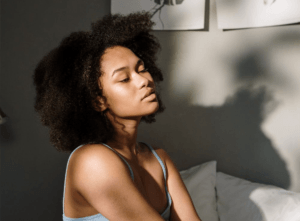 Perhaps you have heard people say, “I need to get my beauty sleep.” It may sound like a joke, but adequate sleep is our cheapest—and most effective—beauty secret. People who consistently experience great sleep are more likely to have bright eyes, clearer skin, and less wrinkles. When you are well rested, you look younger and smile more often. Why? It has to do with what happens while we sleep. And if you don’t get enough high quality sleep, your skin can suffer:
Perhaps you have heard people say, “I need to get my beauty sleep.” It may sound like a joke, but adequate sleep is our cheapest—and most effective—beauty secret. People who consistently experience great sleep are more likely to have bright eyes, clearer skin, and less wrinkles. When you are well rested, you look younger and smile more often. Why? It has to do with what happens while we sleep. And if you don’t get enough high quality sleep, your skin can suffer:
- Dark Circles and Dull Skin: Though dehydration, genetics, and skin tone can contribute to dark circles, lack of sleep is often a major culprit. During sleep our circulatory system removes toxins, distributes nutrients, and boosts the immune system. If sleep is inadequate, this nightly cleansing and boosting is interrupted. Fluid and inflammation builds under the eye and we appear more tired and older than we actually are.
- Wrinkles: Moisture is distributed throughout the body at night while we sleep, repairing skin tissue and giving healthy skin an edge against sun damage. To help this process and reduce wrinkles, stay hydrated, use a sunscreen or sunscreen foundation during the day, and apply a moisturizer at night.
- Saggy Skin: During sleep, our bodies secrete the hormone somatotropin, which provides a “facelift” for the entire body. Somatotropin produces collagen, a protein that improves skin elasticity while keeping our joints pain-free and our bones strong.
- Acne: Inadequate sleep can cause or worsen dermatologic conditions, since skin cells are regenerated and the immune system is strengthened during sleep. Sleep also helps heal inflammation and decreases secretion of the stress hormone cortisol. Without adequate sleep, skin conditions are less responsive to dermatological treatments and can become chronic.
Difficulty Falling Asleep
Even if you sleep well through the night, it can be very hard to fall asleep. Oftentimes, if you struggle to fall asleep it’s because of stress or anxiety. Thinking about things you’re worried about makes it hard to relax and settle in for rest. It may seem counterintuitive, but you want to avoid lying awake in bed for an extended period of time while trying to fall asleep, or else your body will get used to being awake in your bed. Ideally, your bed should be used mainly for sleeping.
Recommendations
- If you’re unable to fall asleep within 20 minutes, get out of bed and go to a different part of your home.
- Do a relaxing activity, such as listening to a guided meditation or calming music, practicing deep breathing, or reading a book.
- Avoid looking at your phone or other electronic device.
- Try to clear your mind of any stressful or negative thoughts, including any frustration you may feel about not being able to fall asleep. Consider writing down your thoughts to help process your feelings.
- Return to bed when you start to feel sleepy again.
- Repeat steps as needed.
If you struggle with falling asleep
- How comfortable is the environment in your bedroom? The lighting, temperature, noise level, etc.
- Are you getting enough physical activity during the day?
- How are your eating habits?
- How are your stress levels? How do you feel you are managing your stress?
- Are you physically uncomfortable? Is your bed supportive enough? Do you need to see a medical provider to address any concerns?
Waking Up Overnight
As a general rule, if you tend to wake up at night and are unable to fall back asleep quickly, you should get out of bed. Similar to staying in bed for an extended period of time before falling asleep, if you’re up in the middle of the night, you want to avoid training your brain to associate being in bed with being awake. It can be frustrating to toss and turn or to watch the clock ticking away anyway, and doing that only makes your brain feel more awake when what you want is the opposite!
Tips to break this pattern:
- If you wake up and are unable to fall back asleep within 20-25 minutes, leave the bedroom entirely and go to another area in your home.
- Avoid doing anything that makes you feel more awake, such as turning on overhead lights, using your phone or tablet,or turning on the TV.Also avoid eating or drinking anything other than a small amount of water.
- Try engaging in relaxing activities, such as reading (the more boring the better), slow breathing, meditation, or even just sitting in a comfortable chair.
- Once you start to feel sleepy, bring yourself back to your bed and re-attempt sleep. If you have the urge to fall asleep in another area of your home (like the couch), try to fight it. Doing that will only create a habit and your brain will further disassociate your bed with sleep.
It is perfectly normal to wake up in the middle of the night and not be able to fall back asleep for 30 or even 45 minutes. It takes time and training for your brain to make the desired associations. Stay consistent and eventually you should notice a shift in your ability to stay asleep (or get back to sleep faster).
Jet Lag and Managing Time Zones
Jet lag is a temporary sleep disruption primarily caused by air travel across two or more time zones. The more time zones crossed, the greater potential for problems with sleep to occur.
Symptoms:
- Daytime fatigue
- Disrupted sleep including insomnia, early waking, or extreme sleepiness
- Difficulty concentrating or functioning
- Stomach problems including constipation or diarrhea
- Generally not feeling well
- Mood swings
Suggestions to minimize jet lag:
- When traveling east, you “lose” time and jet lag symptoms can seem more intense. To help, try to go to bed an hour or two earlier for 3-5 days prior to traveling..
- When flying west, it’s the opposite because you “gain” hours. To prepare, try going to bed an hour or two later a few nights before the trip.
- Drink plenty of water on the flight, as flight dehydration increases symptoms of jet lag. Avoid consuming alcohol and caffeinated beverages.
- Poor sleep quality and quantity makes symptoms of jet lag worse.Practice good sleep hygiene habits prior to travel.
- Regulate light exposure depending on travel direction:
- When heading east, avoid exposure to morning sunlight, and allow for light in the afternoon to promote alertness until the evening.
- When heading west, avoid sunlight in the late afternoon, and make sure to take in plenty of sunlight the following morning.
Sleep Disorders Overview
Shift Work Disorder
If you work the night shift, you may have adjusted to your new routine quickly. Or, you may experience trouble falling asleep during the day due to a mismatch between your body’s circadian rhythm and natural light cycles. If you’re struggling with sleep on this schedule, there are some simple things to do that can help:
Choose a Daytime Sleep Routine
Establishing a daytime sleep routine can be a challenge at first. There are a couple of options to try—sleep experts agree they are both helpful and can be realistically implemented. Give them a try!
- Option #1 (“The 9–5”): Get home from work and stay up for a few hours before a full period of sleep.
- Option #2 (The Naps): Take a short nap when you get home, then stay up for a few hours. The other option is to go to bed when you get home, then stay up a while, then take a longer nap before you have to get up for work.
The key is to plan your sleep so that you wake up close to the start time of your shift. Adding in good sleep habits can help you create a daytime sleep routine that works for you, so you can get the right amount of rest.
In general, sleep experts advise trying to sleep and wake up at around the same times every day, including weekends and when you’re on vacation. This can be difficult when you work a night shift and want to be awake and spend time with friends and family. If you have several days off in a row, or a vacation planned, you can prepare for a sleep switch by taking a long nap after your last shift of the week before the time off. We recommend returning to your daytime sleep schedule as soon as you return to work after a vacation.
For additional tips for managing daytime sleeping, please refer to the Get Better Sleep section
Obstructive Sleep Apnea (OSA)
The two most common conditions related to poor sleep are sleep apnea and insomnia disorder.
Sleep apnea is a type of sleep disorder characterized by repeated apneas, or the stopping and restarting of breathing, throughout a night of sleep. While there are different types of sleep apnea, the most common form is obstructive sleep apnea (OSA), which involves a temporary closure of the airway while sleeping, due to the relaxation of throat muscles.
The primary symptoms of sleep apnea include:
- Loud snoring
- Interrupted breathing while sleeping, often confirmed by another person
- Gasping for air
- Dry mouth upon awakening
- Headaches during daytime
- Frequent waking in the night
- Daytime sleepiness, called hypersomnia
- Poor concentration during daytime
- Irritability
Insomnia Disorder
Insomnia disorder is a clinical mental health diagnosis characterized by prolonged poor sleep quality and quantity, usually involving difficulty falling or staying asleep. What separates a diagnosis of insomnia disorder from more common sleep difficulties is the difficulty sleeping from insomnia must occur for at least three months and at least three days a week, in order for a diagnosis to be made. Additionally there cannot be another cause for lack of sleep such as a medical condition, having a newborn baby, etc.
Restless Leg Syndrome
One of the most common movement disorders that can affect sleep is Restless Leg Syndrome (RLS).
Signs of RLS:
- Twitching and/or uncomfortable sensations in the legs that result in movement
- Occur at rest and relieve with movement
- Worse in evenings
The cause of RLS is largely unknown, and is often correlated to the following factors:
- Family history of RLS
- Pregnancy
- Iron deficiency
- Spinal cord damage
- Peripheral neuropathy
- Obstructive Sleep Apnea
Bruxism (Grinding)
Bruxism is the clinical term for grinding your teeth. It can be a symptom of the following issues:
- Occlusal dysfunction: having an uneven dental bite
- Psychological and emotional distress: when stress creates tension in the muscles in and around your mouth
- Sleep disorders: when a disorder like obstructive sleep apnea can cause you to continually thrust your jaw forward in order to open your airway
Signs you may be grinding your teeth at night:
- Sore jaw muscles/joints
- Headaches in the morning
- Worn down teeth
- Your bed partner hearing grinding sounds
- Fatigue despite adequate hours of sleep
Wearing a mouthguard may protect your teeth, but it’s a good idea to make sure there isn’t also a more significant underlying health issue. If you have concerns about this condition, or others, please reach out to your Crossover care team today.
Relaxation And Sleep
Many people who experience sleep difficulties have feelings of stress, frustration, and even anxiety when thinking about trying to fall asleep. When things get really difficult, people can even find themselves feeling tense, stressed, and anxious in the evening hours because they’re anticipating the battle ahead.
While these feelings are certainly understandable, the problem is, if left unchecked, these emotions actually make it harder for you to feel tired enough to fall asleep. Emotions such as frustration and anxiety are “activating,” meaning they communicate to your brain a need to be awake and alert. This is not helpful to you when you need to feel drowsy enough to fall into a state of sleep. The result is an unhealthy feedback cycle, in which we are stressed prior to, or upon awakening, from sleep. This, in turn, inhibits your brain from helping you feel tired enough to fall back asleep, producing more stress.
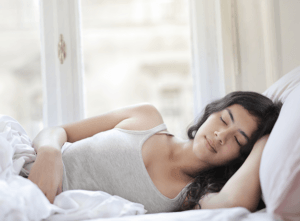 The good news is that there are helpful, evidenced-based techniques that can help either before you get into bed, or if you wake up in the middle of the night. These skills, known as relaxation techniques, are designed to both lower your heart rate and blood pressure, as well as calm the mind. The objective is to slow yourself down and redirect your awareness of your sleep stress. Instead of thinking about the fact that you can’t sleep, it refocuses you on something within your control at that moment. When you do this, your brain responds to your body’s relaxed state, thus creating an environment primed for sleep.
The good news is that there are helpful, evidenced-based techniques that can help either before you get into bed, or if you wake up in the middle of the night. These skills, known as relaxation techniques, are designed to both lower your heart rate and blood pressure, as well as calm the mind. The objective is to slow yourself down and redirect your awareness of your sleep stress. Instead of thinking about the fact that you can’t sleep, it refocuses you on something within your control at that moment. When you do this, your brain responds to your body’s relaxed state, thus creating an environment primed for sleep.
Let’s take a look at a few helpful techniques now.
Diaphragmatic (Deep) Breathing
When you feel distressed, your breathing tends to become shallow and quick, which actually causes your heart rate and blood pressure to increase. This creates more feelings and physical sensations of stress. If someone finds themselves breathing this way in bed, they’re likely to have a harder time both falling and staying asleep.
Fortunately, there’s a simple technique called diaphragmatic breathing that you can learn and start to practice that can relieve both the physical and mental effects of stress.
The diaphragm sits on top of your stomach and when it’s used in your breathing, oxygen is drawn all the way down into the bottom of your lungs, resulting in a deeper and naturally slower breath. By breathing slower and more evenly, you can reduce the physical sensations of stress, while also quieting the mind. This leaves you better prepared to challenge anxious feelings and thoughts.
How It Works
Learning diaphragmatic breathing is a two-step process. The first step is learning how to involve the diaphragm muscle in the breathing process, and the second is learning how to regulate your breathing by keeping a mental count.
Practice using these steps:
- Get in a comfortable position—either stand, sit comfortably with both feet on the floor, or lay down on your back. Once you’re settled, place one hand on your chest and one on your stomach. As the breathing exercise begins, the hand on your chest should stay still (not rise). The hand on your stomach should allow you to feel and visualize your belly rising and falling as you breathe.
- To begin, breathe in through your nose, if you can, for three to five seconds, or as long as you are comfortably able to. Allow your stomach to rise (and your bottom hand to push out) as you draw air fully into your lungs.
- Next, exhale through your mouth, letting the air out slowly, again striving for a duration of 3-5 seconds. This should allow your stomach to fall gently and let your lower hand sink down with it, as the air slowly leaves your lungs.
- Pause for one second before inhaling again. Sometimes it is good to think about a keyword, such as “relax” or “calm,” in your mind during this break.
- Repeat steps 2 through 4 for a total of 1-5 minutes, or until desired level of relaxation is achieved.
Tips for Practice
- Be consistent and patient. Think of diaphragmatic breathing as learning a new skill such as riding a bike. Like any new skill, it will feel clunky and awkward at first and will take practice to master.
- Practice this kind of breathing either before going to bed or just after laying your head down and turning off the lights if you’re experiencing difficulty falling asleep.
- Only practice for two to five minutes at a time, which is usually sufficient to slow your heart rate and increase feelings of relaxation.
- Pick two or three additional times a day to practice.
- Practice focusing your thoughts on your breathing, even if they try to “wander” to thoughts of being awake or falling asleep. Notice whether you can let those thoughts go, and redirect your focus back to your breathing. If you need help, ask your Crossover provider!
- Try to pay attention to differences in how you think and physically feel, both prior to your breathing exercise and after you’ve completed it. Specifically, see if after a few days of practice, you find yourself feeling a little more drowsy before going to bed.
Diaphragmatic Breathing Handout
Progressive Muscle Relaxation
When you’re experiencing stress, you have a tendency to inadvertently tense muscle groups throughout your body. When the stress you feel is around sleep difficulties, movements such as “tossing and turning” contribute to a cycle of stress and muscle tension by putting our bodies in motion rather than allowing them to be still.
Progressive Muscle Relaxation teaches you how to relax your muscles through a two-step process involving tension and release. Through practice, you can learn to distinguish between the feelings of a tensed muscle and a completely relaxed muscle.Then, you can begin to “cue” this relaxed state either before going to bed or when lying in bed preparing to fall asleep. Practicing this skill will help your body relax and be still, which will prepare you for falling and staying asleep.
How to Do It:
Step 1: Tension
- Practice either before going to bed and/or when lying in bed after turning off the lights in preparation for sleep.
- Apply muscle tension to a specific part of the body, such as your hand.
- Focus on the target muscle group, and take a slow, deep breath while squeezing the muscles (e.g., make a tight fist) as hard as you can for about five seconds. It is important to really feel the tension in the muscles, which may even cause a bit of discomfort or shaking (but not pain).
- Try to ONLY tense the muscles you are targeting, not the surrounding muscles.
- Make the muscle tension deliberate, yet gentle. Isolating muscle groups gets easier with practice.
Step 2: Relaxing Tense Muscles
- After about five seconds of tension, let all the tightness flow out of the tensed muscles while exhaling.
- Feel the muscles become loose and limp, as the tension flows out.
- Try to notice the difference between the tension and relaxation. This is the most pivotal part of the whole exercise.
- Remain in this relaxed state for about 15 seconds and then move on to the next muscle group.
- Repeat the tension-relaxation steps.
- After completing all of the muscle groups, take some time to enjoy the deep state of relaxation.
Note: It can take time to learn to relax the body and notice the difference between tension and relaxation. At first, it can feel uncomfortable to be focused on your body, but this can become quite enjoyable over time. You should never feel intense or shooting pain while completing this exercise. Make the muscle tension deliberate, yet gentle. If you have problems with pulled muscles, broken bones, or any medical issues that would hinder physical activity, consult your doctor first.
For a more complete application of this technique, you can try a “progressive” approach that starts from the bottom (feet and toes) and systematically moves all the way up to the top of your body (head). We call this Head to Toe Relaxation. Here’s how it works:
Using the same 5-second inhale/tension, exhale/release cycle from above, try the technique in this order: :
- Right foot (curl your toes downward)
- Lower right leg and foot (tighten your calf muscle by pulling toes towards you)
- Entire right leg (squeeze thigh muscles while doing above)
- (Repeat on left side of body)
- Right hand (clench your fist)
- Entire right arm (tighten your biceps by drawing your forearm up towards your shoulder and “make a muscle” while clenching fist)
- (Repeat on left side of body)
- Buttocks (tighten by pulling your buttocks together)
- Stomach (suck your stomach in or tighten your abdominal muscles)
- Chest (tighten by taking a deep breath)
- Neck and shoulders (raise your shoulders up to touch your ears)
- Mouth (open your mouth wide enough to stretch the hinges of your jaw)
- Eyes (clench your eyelids tightly shut)
- Forehead (raise your eyebrows as far as you can)
It can be helpful to listen to someone guide you through these steps. There are many relaxation recordings available online that will take you through a progressive muscle relaxation (or something very similar).
Alternatively, you, or a friend or relative with a calm, soothing voice can record a script of this process as a voice memo that you can listen to anywhere.
Example: Take a deep breath in through your nose…hold your breath for a few seconds…and now breathe out…take another deep breath through your nose…and exhale. Now pay attention to your body and how it feels…. Start with your right foot… squeeze all the muscles in your right foot. Curl your toes as tight as you can, now hold it….hold it… good…now relax and exhale…let your foot go limp…notice the difference between the tension and relaxation….feel the tension flow out of your foot like water…(then repeat with right lower leg and foot, entire right leg, etc…)
Progressive Muscle Relaxation Handout
Meditation Apps For Sleep
In addition to using music to relax, or to induce or resume sleep, meditation apps can be very helpful. There are hundreds of relaxation apps that offer voice-guided, sleep-inducing meditations and more are always being added.
Examples include:
- Calm
- Headspace
- MeQuilibrium
- Asana Rebel
Find a relaxation app that works best for you. Then, try several different meditations to find the voices, background music, and length of meditation that helps you relax and be still. Listen on a regular basis (like every night before you try to fall asleep). Stay with it. Over time your brain will associate starting the app with relaxation and sleep may come more easily.
If you suspect you may be suffering from one of the sleep disorders or challenges listed above, we encourage you to connect with a Crossover Health provider to discuss treatment options, relaxation techniques, lifestyle changes, and nutrition plans that can help. Crossover’s sleep treatment programs assess for underlying medical conditions that might be affecting your sleep, and offer evidence-based treatment recommendations. If necessary, our Care Navigator will coordinate specialty referrals for extra support.

